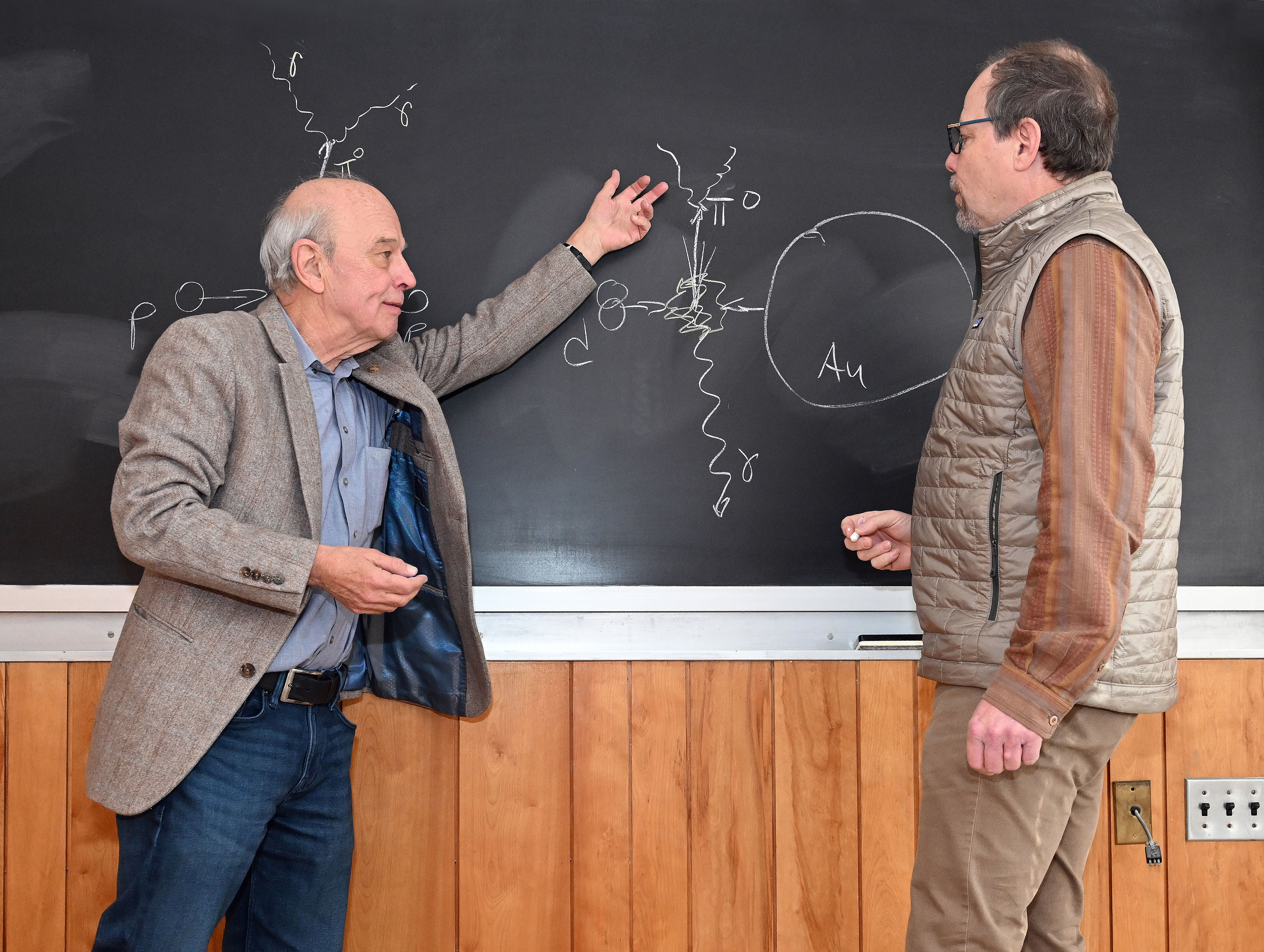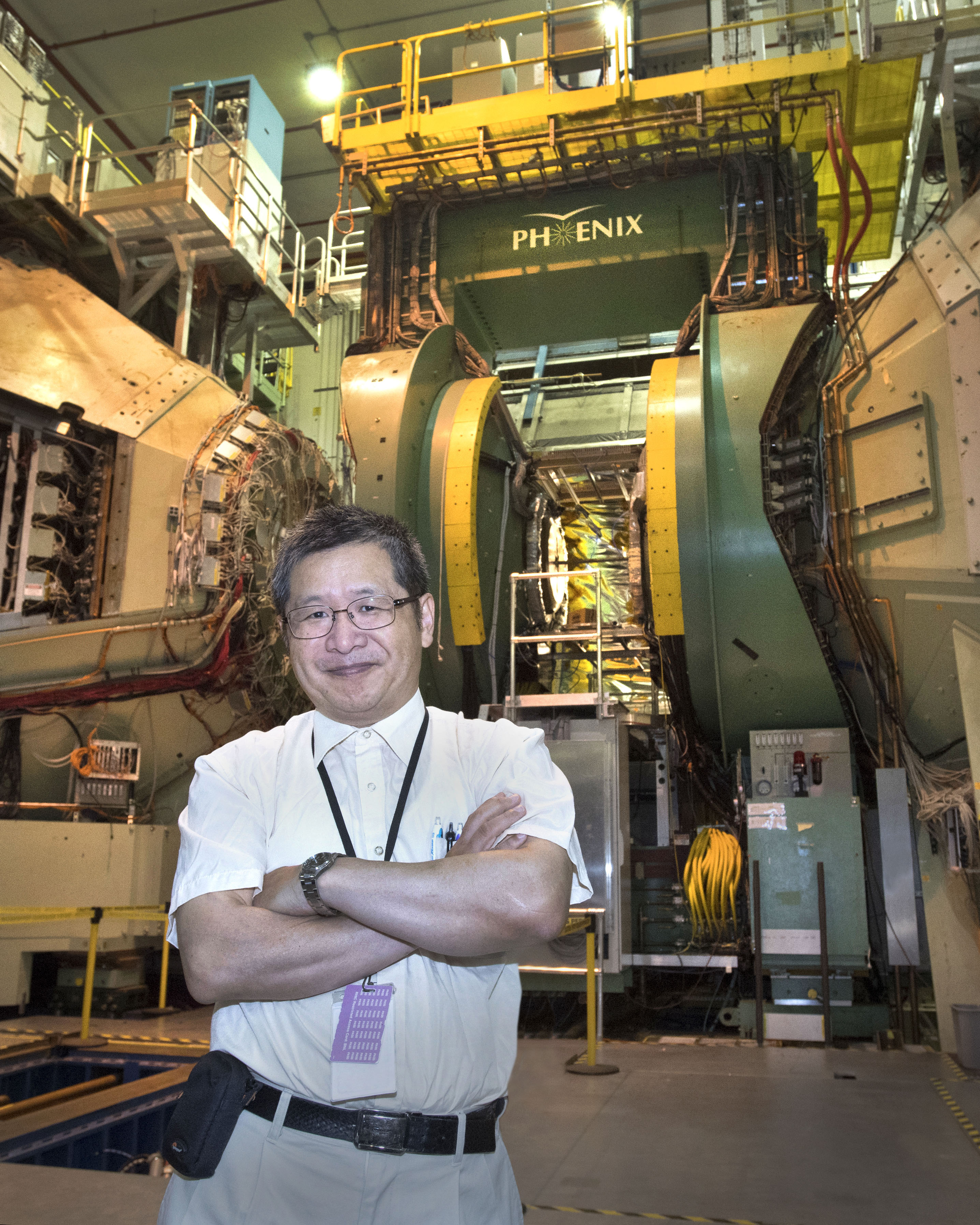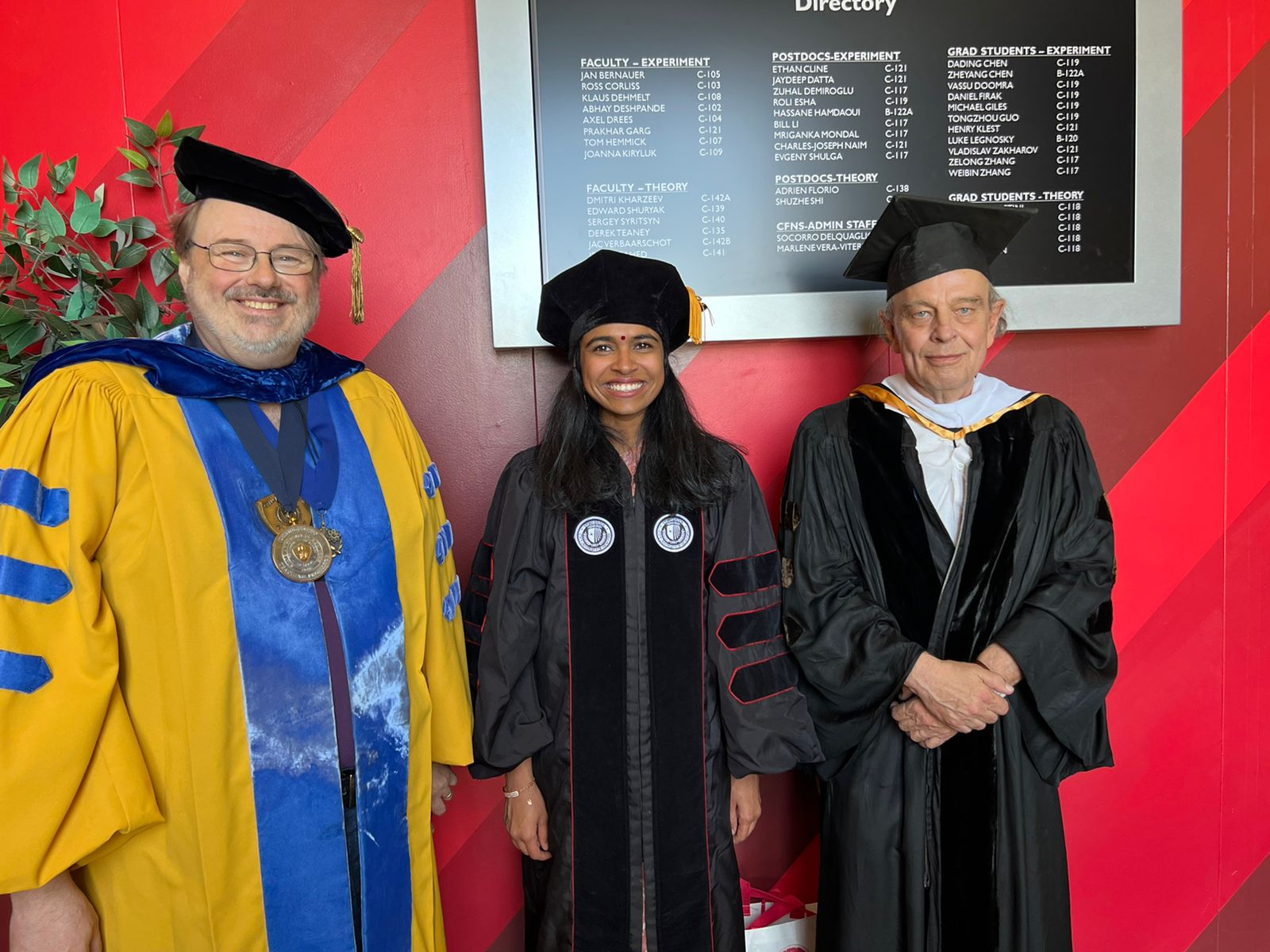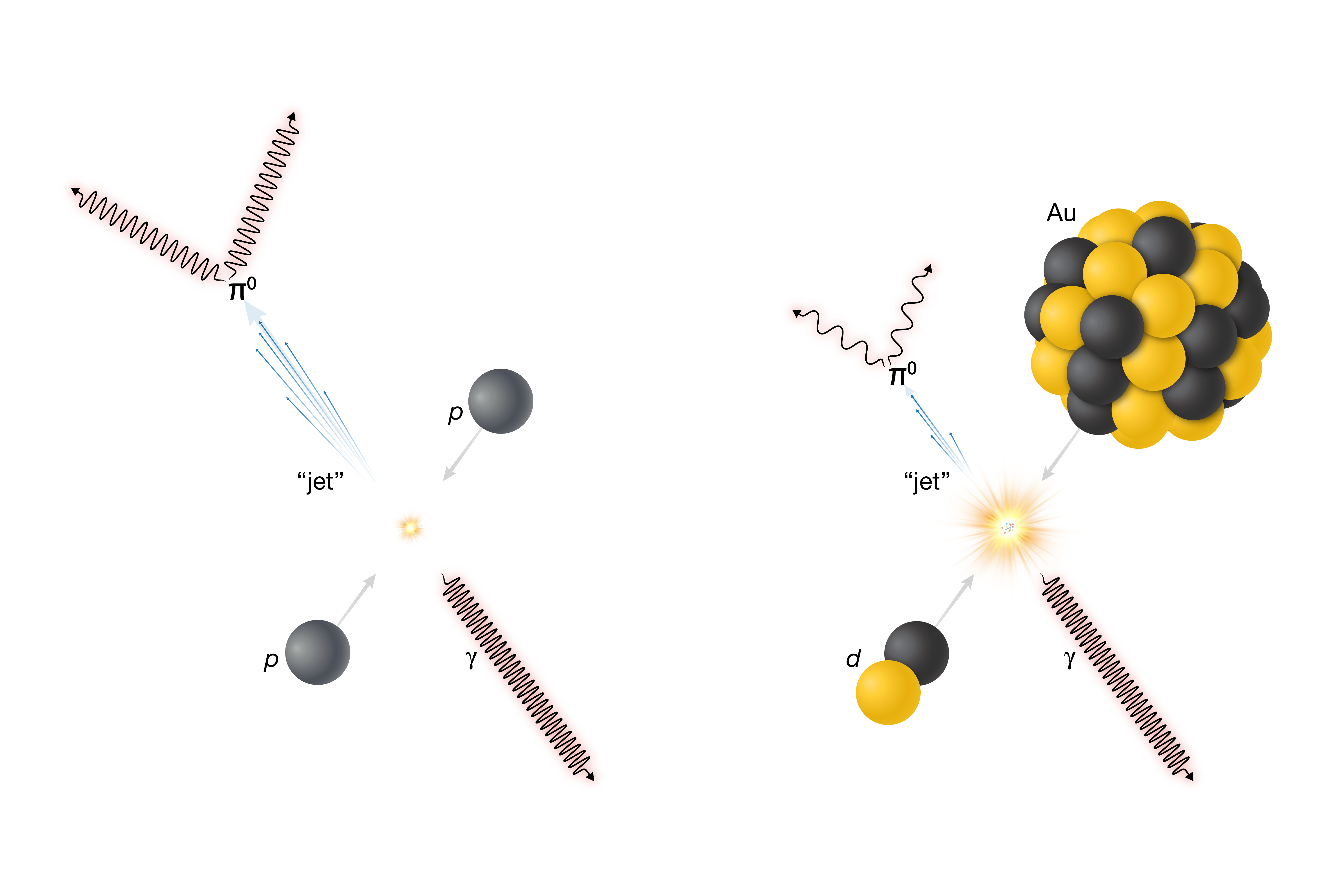UPTON, N.Y. — A new analysis of data from the experiment at the (RHIC) reveals fresh evidence that collisions of even very small nuclei with large ones might create tiny specks of a quark-gluon plasma (QGP). Scientists believe such a substance of free , the building blocks of protons and neutrons, permeated the universe a fraction of a second after the Big Bang. RHIC’s energetic smashups of gold ions — the nuclei of gold atoms that have been stripped of their electrons — routinely create a QGP by “melting” these nuclear building blocks so scientists can study the QGP’s properties.
Physicists originally thought that collisions of smaller ions with large ones wouldn’t create a QGP because the small ion wouldn’t deposit enough energy to melt the large ion’s protons and neutrons. But evidence from PHENIX has that these small collision systems generate particle flow patterns that are consistent with the existence of tiny specks of the primordial soup, the QGP. The new findings, just published in Physical Review Letters, bolster the case for these tiny droplets of the QGP. The paper provides the first direct evidence that energetic particles generated in RHIC’s small collision systems sometimes lose energy and slow down significantly on the way out.
“We found, for the first time in a small collision system, the suppression of energetic particles, which is one of two main pieces of evidence for the QGP,” said PHENIX Collaboration Spokesperson Yasuyuki Akiba, a physicist at Japan’s RIKEN Nishina Center for Accelerator-Based Science and Experiment Group Leader at the (RBRC) at Brookhaven Lab.
Jet quenching as a sign of QGP
Looking for the suppression of high-energy jets of particles, or jet “quenching,” has been a key goal from the earliest days at RHIC, a DOE Office of Science user facility for nuclear physics research that began operating at Brookhaven Lab in 2000. Jets are created when a quark or gluon within a proton or neutron in one of RHIC’s ion beams collides intensely with a quark or gluon in the nuclear particles that make up the beam traveling in the opposite direction. These strong interactions can kick single quarks or gluons free from the colliding nuclear building blocks with tremendous amounts of energy, which quickly transforms the energetic particles into cascades, or jets, of other particles.
If the collision doesn’t melt the nuclear matter into a soup of free quarks and gluons — the QGP — then these energetic jets of particles, or their decay products, sail out freely to be counted by RHIC’s detectors. But if the collisions do form a QGP, the kicked-free quark or gluon, despite its energy, gets caught up in interactions with the quarks and gluons that make up the plasma.
“Those interactions lead to energy loss,” explained Gabor David, a PHENIX physicist from Stony Brook University (SBU) who was one of the leaders of the new analysis.
“You can think about it like the difference between running through air and running through water,” he said. The QGP is like the water; it slows the particles down. As a result, jets reach the detector with only a fraction of their original energy.
To look for this suppression, the physicists first must estimate the number of energetic particles that would be expected from the gold-gold smashups by mathematically scaling up from simple proton-proton collisions to the number of protons and neutrons involved in collisions of heavier ions such as gold. The calculated values indirectly indicate whether the collision happens dead-center between the two gold ions or if it’s a glancing collision where the ions sideswipe one another at the edges. Central collisions are expected to create more jets than peripheral ones. But they’re also more likely to generate bigger QGP and therefore higher jet suppression.
This method has worked beautifully for the gold-gold smashups.
“We expected we should see 1,000 times the number of energetic particles, or jets, in the most central gold-gold collisions compared to proton-proton collisions,” Akiba said. “But we saw only about 200 times the proton-proton level, one-fifth the expected number. That’s a factor of five suppression.”
This jet suppression is a clear sign that the gold-gold collisions are generating the QGP. It’s also consistent with another key signature of the QGP formation in these collisions — namely, characteristic patterns of particle flow caused by hydrodynamic properties of the “” plasma.
When PHENIX scientists observed similar hydrodynamic flow patterns in small collision systems, hinting that there might be tiny drops of the QGP, they set out to search for jet suppression in those events as well. The results were a surprise: While the most central collisions of particles such as deuterons — one proton and one neutron — with gold ions exhibited signs of jet suppression, more peripheral collisions seemed to show an increase in energetic jets.
“There was no explanation for why this should happen — absolutely none,” David said.
Turning to direct photons
As it turns out, the surprising increase was an artifact of the indirect way the physicists had determined the centrality of the collisions. They discovered this by trying an alternate and more direct approach, as described in the new paper. Instead of using calculations based on a geometric model to estimate the number of nuclear particles — protons and neutrons — participating in the collisions, they used a direct measurement of those interactions by counting so-called “direct” photons.
This is possible because just as a RHIC collision can kick an energetic quark or gluon free, that interaction can also produce a high energy photon, or particle of light. These direct photons are produced in the collision right along with and in amounts proportional to the kicked-free quarks and gluons.
So, by counting the direct photons that strike their detector, the PHENIX scientists could directly measure the centrality of the collisions and know exactly how many energetic quarks or gluons were kicked free — that is, how many jets to expect.
“The more central the collision is, the more interactions there can be between the quarks and gluons of a small colliding deuteron with the quarks and gluons in the protons and neutrons of a gold ion,” explained Axel Drees of SBU, another leader of the analysis. “So, central smashups produce more direct photons and should produce more energetic jet particles than glancing collisions do.”
But unlike the quarks and gluons, the photons don’t interact with the QGP.
“If photons are created, they escape the QGP completely without any energy loss,” Drees said.
So, if there’s no QGP, the photons and energetic particles should be detected in proportionate amounts. But if in central collisions the number of energetic jet particles detected is significantly lower than the number of direct photons of the same energy, that could be a sign that a QGP is present, quenching the jets.
Niveditha Ramasubramanian, who was a graduate student advised by David at the time, undertook the challenging task of teasing out the direct photon signals from PHENIX’s deuteron-gold collision data. When her analysis was complete, the earlier, unexplained increase in jets emerging from peripheral collisions completely disappeared. But there was still a strong signal of suppression in the most central collisions.
“The initial motivation to do this complex analysis was only to better understand the strange increase in energetic jets in peripheral collisions, which we did,” said Ramasubramanian, a co-author on the paper who earned her Ph.D. — and a Thesis Award at the — for her contributions to this result. Now a staff scientist at the French National Centre for Scientific Research, she added, “The suppression that we observed in the most central collisions was entirely unexpected.”
“When we use the direct photons as a precise, accurate measure of the collision centrality, we can see the suppression [in central collisions] unambiguously,” Akiba said.
David noted that, “The new method relies solely on observable quantities, avoiding the use of theoretical models.”
The next step will be to apply the same method to other small collision systems.
“Ongoing analyses of PHENIX’s proton-gold and helium-3-gold data with the same technique will help to further clarify the origins of this suppression to confirm our current understanding or rule it out by competing explanations,” Drees said.
This research was funded by the DOE Office of Science (NP), the National Science Foundation, and a range of U.S. and international universities and organizations listed in the scientific paper. The PHENIX experiment collected data at RHIC from 2000 until 2016 and, as this paper indicates, analysis of its data is ongoing.
Brookhaven National Laboratory is supported by the Office of Science of the U.S. Department of Energy. The Office of Science is the single largest supporter of basic research in the physical sciences in the United States and is working to address some of the most pressing challenges of our time. For more information, visit .
Follow @BrookhavenLab on social media. Find us on , , , and .
MEDIA CONTACT
Register for reporter access to contact detailsArticle Multimedia

Credit: Kevin Coughlin/Brookhaven National Laboratory
Caption: Stony Brook University physicists Gabor David and Axel Drees sketch out how a signal of jet energy loss in deuteron-gold collisions at the Relativistic Heavy Ion Collider (RHIC) supports the case that these collisions create small specks of quark-gluon plasma, a form of matter that permeated the early universe.

Credit: Brookhaven National Laboratory
Caption: PHENIX Collaboration Spokesperson Yasuyuki Akiba at the PHENIX detector, which collected data at the Relativistic Heavy Ion Collider (RHIC) from 2000 to 2016. A new analysis of PHENIX data provides fresh evidence that collisions of small particles with large nuclei create small specks of quark-gluon plasma.

Credit: Courtesy of Niveditha Ramasubramanian
Caption: Niveditha Ramasubramanian (center), who earned her Ph.D. in physics from Stony Brook University (SBU) in part for her analysis of direct photons in PHENIX's deuteron-gold collision data, with her two SBU thesis advisors, Thomas Hemmick (left) and Gabor David (right).

Credit: Valerie Lentz/Brookhaven National Laboratory
Caption: A penchant for photons and neutral pions: PHENIX is particularly good at detecting photons (wavy lines, Ξ³). To detect jets, PHENIX measures the photons that neutral pions (Ο0) β often the leading particles that make up jets β decay into. Distinguishing between direct photons β those that come from the interaction of quarks and gluons in the collision β and decay photons, like those from the decay of a neutral pion or other particles in a jet, is a complicated, but well-established and proven procedure and was essential to the new PHENIX result. The image shows the difference between an energetic jet emerging from a proton-proton (p-p) collision, where no quark-gluon plasma (QGP) forms, and a jet that gets "quenched" β or loses energy β in a collision of a deuteron (d) with a gold (Au) nucleus. Note that direct photons (lower Ξ³) emerge unaffected from each collision. The combination of equal-energy direct photons with jet-energy loss is a clear sign that QGP is forming in central deuteron-gold collisions.
CITATIONS

